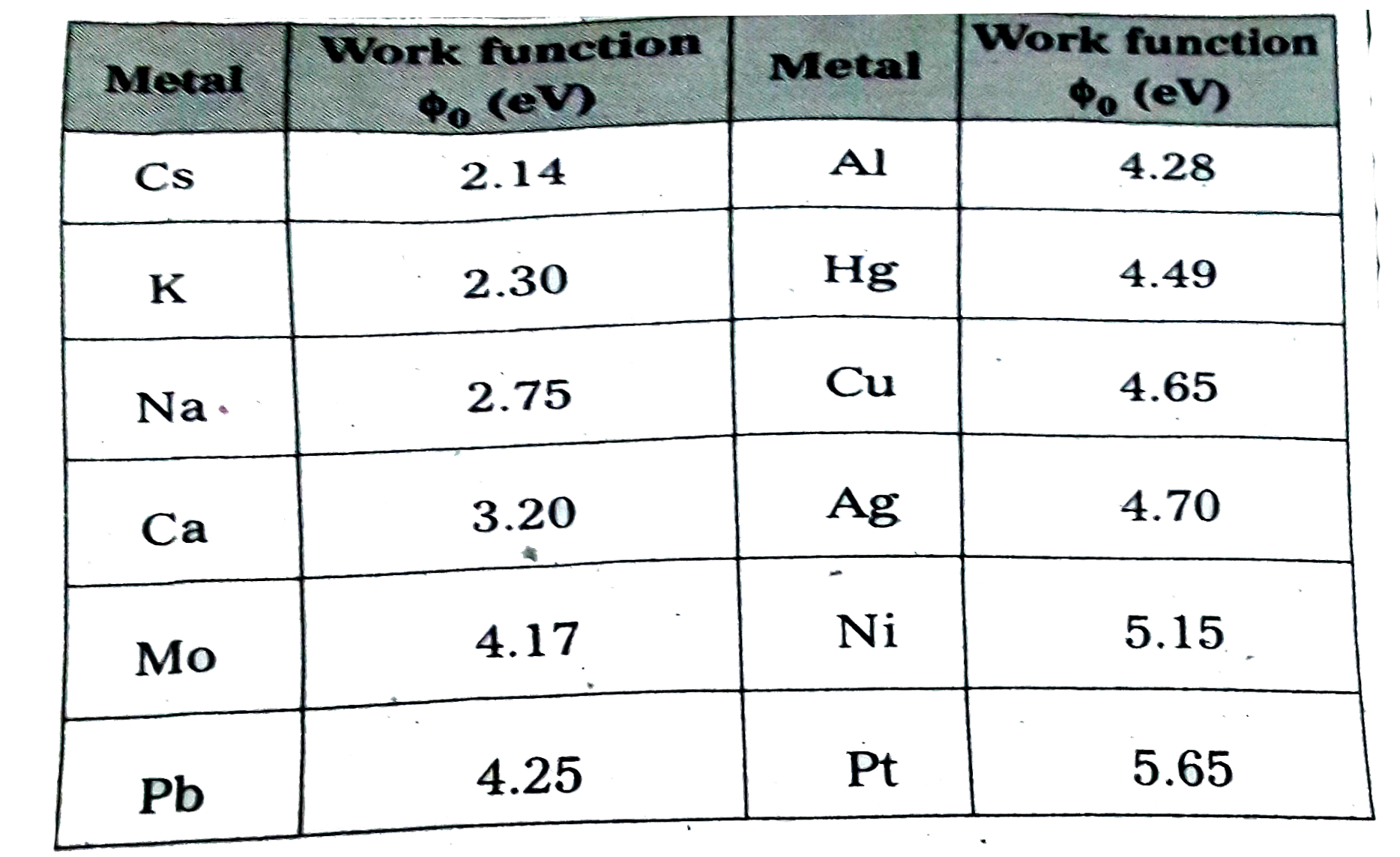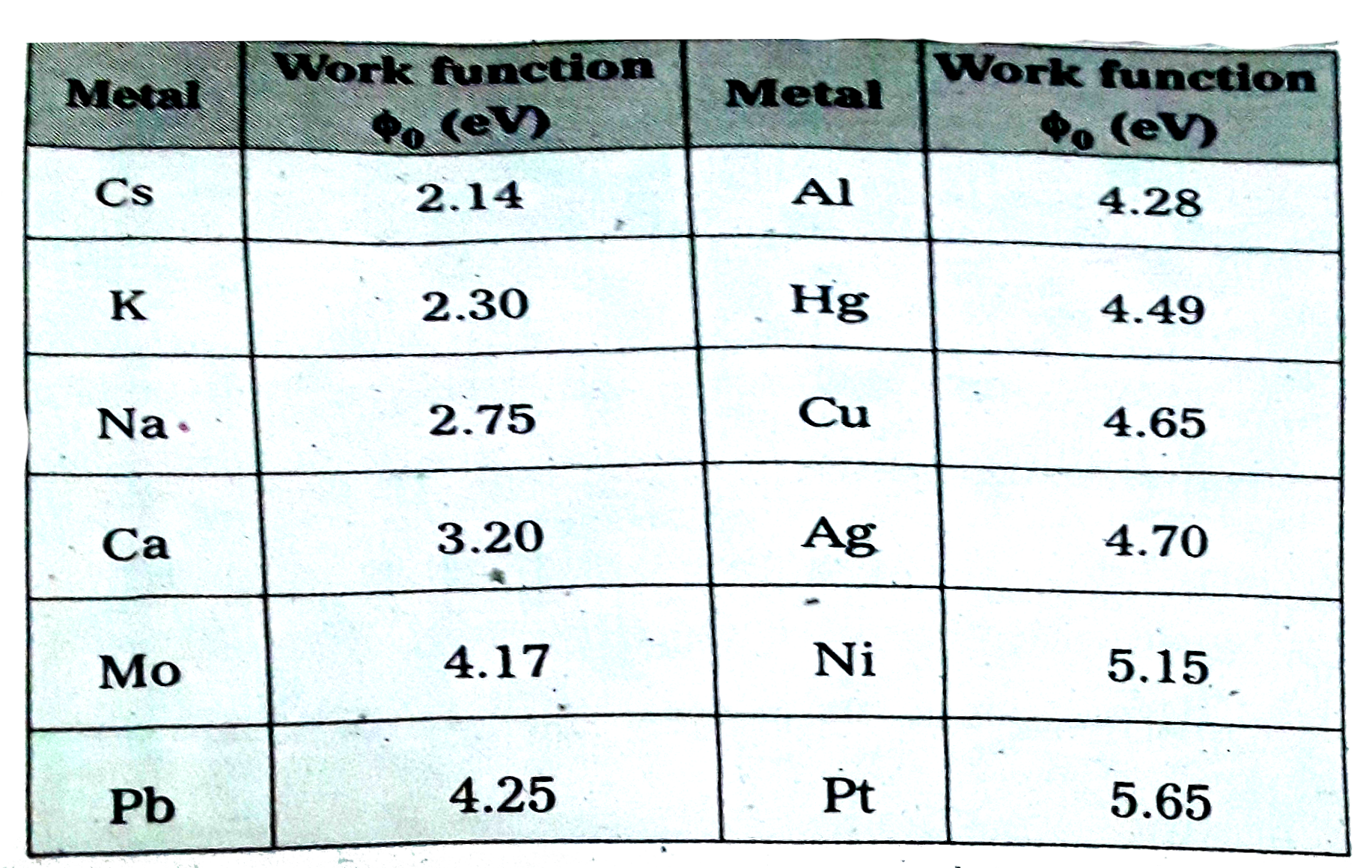The wavelength of light in the visible region is about 390 nm for violet colour, about 550 nm (average wavelength) for yellowgreen colour and about 760 nm for red colour. (a) What are the energies of photons in (eV) at the (i) violet end, (ii) average wavelength, yellow-green colour, and (iii) red end of the visible spectrum? (Take h =6.63×10−34 J s and 1 eV=1.6×10−19J.)
(b) From which of the photosensitive materials with work functions listed in Table 11.1 and using the results of (i), (ii) and (iii) of (a), can you build a photoelectric device that operates with visible light?Solution in Gujrati
(a) Eneergy of the incident photon, E=hv=hc/λ
E=(6.63×10−34Js)(3×108m/s)/λ
=1.989×10−25Jmλ
(i) For violet light, λ1=390nm (lower wavelength end)
Incident photon energy, E1=1.989×10−25Jm390×10−9m
=5.10×10−19J
=5.10×10−19J1.6×10−19J/eV
=3.19eV
(ii) For yellow - green light, λ2=550nm (average wavelength)
Incident photon energy, E2=1.989×10−25Jm550×10−9m
=3.62×10−19J=2.26ev
(iii) For red light, λ3=760nm (higher wavelength end)
Incident photon energy, E3=1.989×10−25Jm760×10−9m
=2.62×10−19J=1.64ev
(b) For a photoelectric device to operate, we require incident light energy E to be equal to or greater than the work function ϕ0 of the material. Thus, the photoelectric device will operate with violet light (with E = 3.19 ev) photosensitive material Na(with ϕ0=2.75eV),K(with ϕ0=2.30eV)andCs(with ϕ0=2.14eV). It will also operate with yellow-green light (with E =2.26eV) for Cs (with ϕ0=2.14eV) only. However, it will not operate with red light (with E = 1.64 eV) for any of these photosensitive materials.
Topper's Solved these Questions
- DUAL NATURE OF RADIATION AND MATTERBOOK - NCERT GUJARATICHAPTER - DUAL NATURE OF RADIATION AND MATTEREXERCISE - EXERCISES
41 Videos
- CURRENT ELECTRICITY BOOK - NCERT GUJARATICHAPTER - CURRENT ELECTRICITY EXERCISE - ADDITIONAL EXERCISES
9 Videos
- ELECTRIC CHARGES AND FIELDS BOOK - NCERT GUJARATICHAPTER - ELECTRIC CHARGES AND FIELDS EXERCISE - EXERCISES
34 Videos
Similar Questions
Find the
(a) maximum frequency, and
(b) minimum wavelength of X-rays produced by 30 kv electrons.
View SolutionThe earth's surface has a negative surface charge density of 10−9Cm−2. The potential difference of 400 kV between the top of the atmosphere and the surface results (due to the low conductivity of the lower atmosphere) in a current of only 1800 A over the entire globe. If there were no mechanism of sustaining atmospheric electric field, how much time (roughly) would be required to neutralise the earth's surface? (This never happens in practice because there is a mechanism to replenish electric charges. namely tghe coontainual thunderstorms and lighting in different parts of the globe). (Radius of earth =6.37×106m.)
View SolutionWhat is the force between two small charged speres having charges of 2×10−7 c and 3×10−7 c placed 30 cm apart in air
View SolutionThe wavelength of light in the visible region is about 390nm for violet colour, about 550nm (average wavelength) for yellow green colour and about 760nm for red colour. What are the energies of photon in eV at the (i) violet end (ii) average wavelength yellow-green colour and (iii) red end of the visible spectrum? (Take h=6.63×10−34Jsand1eV=1.6×10−19Js)
View SolutionThe wavelength of light in the visible region is about 390 nm for violet colour and about 760 nm for red colour. The energy of photon in eV at violet end is
View SolutionThe wavelength of light in the visible region is about 390 nm for violet colour, about 550 nm (average wavelength ) for yellow - green colour and about 760 nm for red colour .
(a ) What are the energies of photons in (ev) at the (i) violet end, (ii) average wavelength , yellow - green colour , and (ii) red end of the visible spectrum ? (Take h = 6.63×10−34 J s and 1 eV= 1.6×10−19 J ) ,

View SolutionThe wavelength of light in the visible region is about 390 nm for violet colour, about 550 nm (average wavelength ) for yellow - green colour and about 760 nm for red colour .
From which of the photosensitive materials with work functions listed in table and using the results of (i) , (ii) and (iii) of (a) can you build a photoelectric device that operates with visible light ?

View Solutionदृश्य क्षेत्र में बैंगनी रंग ,पिले-हरे रंग तथा लाल रंग के प्रकाश के तरंगदैर्घ्य क्रमशः लगभग 390n,m,500nm (औसत तरंगदैर्ग्य) तथा 760nm है।
दृश्य क्षेत्र के निम्न प्रकाश के लिए फोटॉन की ऊर्जा (eV में) क्या होगी-
(i) बैगनी सिरा (ii) पिले-हरे रंग औसत तरंगदैर्घ्य तथा (iii) लाल सिरा।
[h=6⋅63×10−34Js तथा 1eV=1⋅6×10−19J]
View Solutionदृश्य क्षेत्र में बैंगनी रंग, पीले-हरे रंग तथा लाल रंग के प्रकाश की तरंगदैर्ध्य क्रमश: लगभग 390 nm, लगभग 550 nm (औसत तरंगदैर्ध्य) तथा लगभग 760 nm है।
(a) दृश्य क्षेत्र के निम्न प्रकाश के लिए फोटॉन की ऊर्जा (eV) क्या होगी - (i) बैंगनी सिरा, (ii) पीले-हरे रंग की औसत तरंगदैर्ध्य, तथा (iii) लाल सिरा (h=6.63×10−34Js तथा 1eV=1.6×10−19J)
(b) प्रकाश-संवेदी पदार्थों के लिए सारणी में दिए गए कार्य-फलनों के मान तथा (a) प्रश्न के (i), (ii) तथा (iii) भागों के परिणामों को उपयोग में लाते हुए क्या आप दृश्य प्रकाश के साथ कार्य कर सकने वाली प्रकाश विद्युत युक्ति का सृजन कर सकते हैं?
View SolutionThe wavelength of light in the visible region is about 390 nm for violet colour, about 550 nm (average wavelength ) for yellow - green colour and about 760 nm for red colour .
(a ) What are the energies of photons in (ev) at the (i) violet end, (ii) average wavelength , yellow - green colour , and (ii) red end of the visible spectrum ? (Take h = 6.63×10−34 J s and 1 eV= 1.6×10−19 J ) ,

View SolutionThe wavelength of light in the visible region is about 390 nm for violet colour, about 550 nm (average wavelength) for yellowgreen colour and about 760 nm for red colour. (a) What are the energies of photons in (eV) at the (i) violet end, (ii) average wavelength, yellow-green colour, and (iii) red end of the visible spectrum? (Take h =6.63×10−34 J s and 1 eV=1.6×10−19J.)
(b) From which of the photosensitive materials with work functions listed in Table 11.1 and using the results of (i), (ii) and (iii) of (a), can you build a photoelectric device that operates with visible light?
View SolutionThe wavelength of light in the visible region is about 390 nm for violet colour, about 550 nm (average wavelength) for yellowgreen colour and about 760 nm for red colour. What are the energies of photons in (eV) at the (i) violet end, (ii) average wavelength, yellow-green colour, and (iii) red end of the visible spectrum? ("Take h "= 6.63xx10^(-34)" J s and 1 eV" = 1.6xx10^(-19)J.)
View SolutionThe wavelength of light in the visible region is about 390 nm for violet colour, about 550 nm (average wavelength) for yellowgreen colour and about 760 nm for red colour. (a) What are the energies of photons in (eV) at the (i) violet end, (ii) average wavelength, yellow-green colour, and (iii) red end of the visible spectrum? ("Take h "= 6.63xx10^(-34)" J s and 1 eV" = 1.6xx10^(-19)J.) (b) From which of the photosensitive materials with work functions listed in Table 11.1 and using the results of (i), (ii) and (iii) of (a), can you build a photoelectric device that operates with visible light?
View SolutionThe wavelength of light in the visible region is about 390 nm for violet colour, about 550 nm (average wavelength) for yellowgreen colour and about 760 nm for red colour. What are the energies of photons in (eV) at the (i) violet end, (ii) average wavelength, yellow-green colour, and (iii) red end of the visible spectrum? (Take h =6.63×10−34 J s and 1 eV=1.6×10−19J.)
View SolutionThe wavelength of light in the visible region is about 390 nm for violet colour, about 550 nm (average wavelength) for yellow-green colour and about 760 nm for red colour. From which of the photosensitive materials with work functions listed given below and using the results of (i), (ii) and (iü) of (a), can you build a photoelectric device that operates with visible light ?
View Solution
